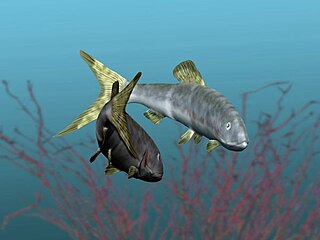
The Cerophytidae are a family of beetles belonging to Elateroidea. Larvae are associated with rotting wood, on which they are presumed to feed. The family contains over 20 species in five genera, primarily distributed in the New World, but also in Eurasia and Africa. 17 fossil species in 7 genera are known extending to the Early Jurassic. Like some other elateroids, the adults are capable of clicking.

Anaxyelidae is a family of incense cedar wood wasps in the order Hymenoptera. It contains only one living genus, Syntexis, which has only a single species, native to Western North America. Fossils of the family extend back to the Middle Jurassic, belonging to over a dozen extinct genera, with a particularly high diversity during the Early Cretaceous. Syntexis lay eggs in the sapwood of conifers, preferring recently burnt wood.
Cacibupteryx is a genus of rhamphorhynchid pterosaur from the middle-late Oxfordian-age Upper Jurassic Jagua Formation of Pinar del Río, Cuba.
Nesodactylus was a genus of rhamphorhynchid pterosaur from the middle-late Oxfordian age Upper Jurassic Jagua Formation of Pinar del Río, western Cuba.

Aspidoceras is an extinct ammonoid cephalopod genus belonging to the family Aspidoceratidae.

Nemestrinidae, or tangle-veined flies is a family of flies in the superfamily Nemestrinoidea, closely related to Acroceridae. The family is small but distributed worldwide, with about 300 species in 34 genera. Larvae are endoparasitoids of either grasshoppers (Trichopsideinae) or scarab beetles (Hirmoneurinae). Some are considered important in the control of grasshopper populations. Adults are often observed on flowers.

Psychopsidae is a family of winged insects of the order Neuroptera. They are commonly called silky lacewings.

Steneosaurus is a dubious genus of teleosaurid crocodyliform from the Middle or Late Jurassic of France. The genus has been used as a wastebasket taxon for thalattosuchian fossils for over two centuries, and almost all known historical species of teleosauroid have been included within it at one point. The genus has remained a wastebasket, with numerous species still included under the label ‘Steneosaurus’, many of which are unrelated to each other.
Vinialesaurus is a genus of plesiosaur from the Late Jurassic (Oxfordian) Jagua Formation of Pinar del Río, Cuba. The type species is Vinialesaurus caroli, first described as Cryptocleidus caroli by De la Torre and Rojas in 1949 under the holotype MNHNCu P 3008, and redescribed by Gasparini, Bardet and Iturralde in 2002. The authors of the 2002 paper considered Vinialesaurus distinct enough from Cryptocleidus to warrant its own genus, but it was broadly similar to Cryptocleidus.

Varasichthys is an extinct genus of ray-finned fish that lived during the Oxfordian stage of the Late Jurassic epoch. It contains one species, Varasichthys ariasi, fossils of which have been found in the Domeyko Range of Antofagasta Region, northern Chile. It has been placed in the family Varasichthyidae together with the genera Bobbichthys, Domeykos, Luisichthys and Protoclupea.
Antofagastaichthys is an extinct genus of ray-finned fish that lived in what is now Chile during the Oxfordian stage of the Late Jurassic epoch. It contains one species, A. mandibularis, which is known from several fragmentary specimens discovered in the El Profeta Formation of Antofagasta Province.
Chongichthys is an extinct genus of marine ray-finned fish that lived during the Oxfordian stage of the Late Jurassic epoch. It contains one species, C. dentatus from the Quebrada El Profeta of Chile. It is named after Chilean geologist Guillermo Chong.
Protoclupea is an extinct genus of ray-finned fish that lived from the Oxfordian to the early Tithonian stage of the Late Jurassic epoch. It contains one species, Protoclupea chilensis, fossils of which have been found in the Domeyko Range of Antofagasta Region, northern Chile. The genus has been placed in the family Varasichthyidae together with the genera Bobbichthys, Domeykos, Luisichthys and Varasichthys.
Eugnathides is an extinct genus of prehistoric bony fish that lived from the Oxfordian to the early Tithonian stage of the Late Jurassic epoch. Eugnathides may have been similar to Sphaerodontes.

Luisichthys is an extinct genus of ray-finned fish that lived in what is now Cuba from the Oxfordian to the early Tithonian stage of the Late Jurassic epoch. It contains one species, Luisichthys vinalesensis.

Ithonidae, commonly called moth lacewings and giant lacewings, is a small family of winged insects of the insect order Neuroptera. The family contains a total of ten living genera, and over a dozen extinct genera described from fossils. The modern Ithonids have a notably disjunct distribution, while the extinct genera had a more global range. The family is considered one of the most primitive living neuropteran families. The family has been expanded twice, first to include the genus Rapisma, formerly placed in the monotypic family Rapismatidae, and then in 2010 to include the genera that had been placed into the family Polystoechotidae. Both Rapismatidae and Polystoechotidae have been shown to nest into Ithonidae sensu lato. The larvae of ithonids are grub-like, subterranean and likely phytophagous.

Cardioceras is an extinct ammonite genus belonging to the family Cardioceratidae. These fast-moving nektonic carnivores lived during the Jurassic period, Oxfordian age.
Ochetoceras is a genus of ammonites, belonging to the Oppeliidae, that lived during the Late Jurassic from the early Oxfordian to the early Tithonian, and type for the subfamily Ochetoceratinae.

Kranaosphinctes is an extinct genus of ammonites belonging to the Perisphinctidae family. Some authors consider Kranaosphinctes a subgenus of the genus Perisphinctes.

Archisargidae is an extinct family of brachyceran flies known from the Jurassic and Cretaceous periods. It is part of the extinct superfamily Archisargoidea. Most members of the family are known from the Callovian-Oxfordian Daohugou biota of Inner Mongolia, China, and the equivalently aged Karabastau Formation of Kazakhstan. The family has been found to be paraphyletic with respect to Eremochaetidae in a cladistic analysis.












